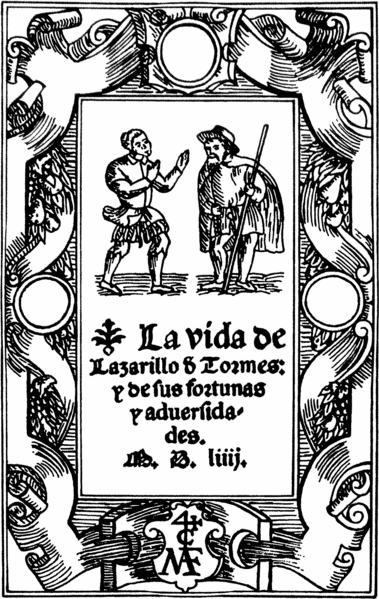top of page


Lazarillo de Tormes
A Famous Literary Character
The Spanish boy named Lazarillo de Tormes is a famous literary character.
The story of Lazarillo de Tormes was written around 1554 but the author's identity is unknown. It is an anonymous work.
Below: a picture of the book's cover when it was first published in 1554.

When the story first appeared, it was banned because it was considered to be scandalous.
The book belongs to the Spanish Golden Age of literature (El Siglo de Oro). This was an important cultural period in Spain between the 15th and 17th centuries during which there was an abundance of great Spanish art and literature.
The character Lazarillo has some similarities to the character known as the Artful Dodger in the novel Oliver Twist by Charles Dickens. The Spanish story is about a young boy who works for a series of masters. It tells of his adventures and mishaps. In fact, Lazarillo de Tormes was perhaps the first story published of this kind. It is known as una novela picaresca - a picaresque novel - and the boy is known as un pícaro, travelling between masters, from one existence to another.
The book is written in the 'first person', as if the adult Lazarillo is telling the story of his childhood. It is divided into an introduction - prólogo - and seven chapters called 'tratados.'
There are many famous, funny and cruel scenes throughout the story. For example, in one scene, Lazarillo claims that mice are eating the bread stored in a chest. Instead, it is Lazarillo who is stealing the bread and even the cheese from the mouse-trap!

In another famous scene, Lazarillo steals a sausage that is being grilled on a skewer and replaces it with a turnip.
In this painting by Francisco de Goya, Lazarillo's first master is searching for evidence of the stolen sausage.
The Story:
Lazarillo was born in the city of Salamanca on the banks of the river Tormes - el río Tormes. That is why he was named Lazarillo of Tormes. He lived in poverty so he left home to search for work.
He found work as a servant for the following masters:
1. un ciego - a blind beggar
2. un clérigo - an unkind priest
3. un escudero - a poor nobleman
4. un fraile - a friar
5. un buldero - a pardoner
6. un capellán - a chaplain
7. un alguacil - a constable
Each time that he chose a new master, Lazarillo found himself guessing if he would be happy with that person, or not. It soon became clear that it is impossible to judge someone by their appearance. A kind-looking person could in reality be cruel and a wealthy-looking person could in reality be poor and starving.
Lazarillo ran away from all his masters except for the nobleman. The surprising thing about this master is that he appeared to be a wealthy man of the upper-class. He lived in a large house, dressed well and walked around the town with pride. However, in reality, he was very poor and had no money, furniture or food.
The nobleman's existence was based on how he appeared to other people. He was too proud to beg so he used Lazarillo to beg for him. He was kind to Lazarillo, but as he had no food it meant that Lazarillo had to suffer from terrible hunger. In the end, the nobleman - el escudero - abandoned Lazarillo. One day he simply did not return home.
The story ends with Lazarillo finding a permanent job as a town-crier, calling out the price of wine and selling it. He eventually marries a servant-girl.
In the town of Salamanca (the boy's home-town), there is a statue of Lazarillo with his first master - the blind beggar, (below.)

A pícaro like Lazarillo, has the following characteristics:
1. He is young.
2. He is poor.
3. He is good at stealing.
4. He moves from one master to another.
5. He is practical and clever.
6. He is tough, in order to cope with such a hard life.
7. He makes the most of any good luck because he knows it will probably not last for long.
El Lazarillo de Tormes is a really great story!
Famous Spanish People
Spanish Zone
Literature Zone
bottom of page